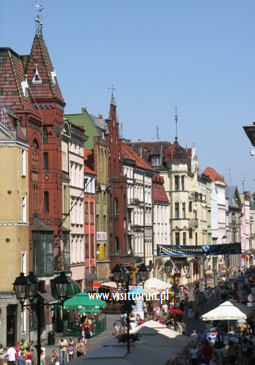|
In the spring of 2009 twenty two stylized crests of the Hanseatic cities, which remained lively commercial contacts with Toruń in the Middle Ages, established a unique alley in the Szeroka Street in Toruń.
The panels were made of steel, brass, bronze and reddish black stone. 22 characters are reminding residents and tourists heyday of Toruń's history - Middle Ages and early modern era. Toruń itself was also the vibrant centre of the Hanseatic League - an economic union of trading cities of Northern Europe, which comprised the most important cities in the area of Baltic Sea and North Sea.
Crests project is based on the reconstruction of the frieze of heraldic symbols on the facade of the former Artus Court in Toruń.
The heraldic frieze was placed horizontally above the ground floor cornice. It could be part of the medieval (late fifteenth century) decoration of the building, despite its facade ornamentation was rebuilt during the Renaissance. From this time we know the illustration of the Arthus House by G. F. Steiner - a famous Toruń illustrator.
|

Szeroka Street, general view
|
|
Frieze of heraldic symbols on the facade of the former Artus Court
|
The first five coats of arms are arms of the Prussian cities, as following: Chełmno, Toruń, Elbląg, Königsberg, Gdańsk.
Subsequent coats of arms for cities: Bremen, Dortmund, Soest, Lübeck, Osnabrück, Nuremberg, Regensburg, Braunschweig, Cologne, Hamburg, Wrocław, Stralsund, Rostock, Leiden, Naumburg, Erfurt, Münster.
The exception among this set of coats of arms is an indication of the Hanseatic cities of Nuremberg and Leiden, which actually didn't belong to the Hanseatic League, and were its competitors. Without a doubt, however, Nuremberg and Leiden belonged - like the other cities - to the most important commercial centres of Europe and to the cities, with which Toruń maintained wide contacts.
All of the cities that the arms symbolize - except Chełmno - were consisting the group of large and major European cities, counting in the Middle Ages over 10 thousand residents.
The alley continuation are several crests added in 2010 in Królowej Jadwigi (St. Queen Hedwig) Street - an extension of Szeroka Street towards the New City Market Square.
Here are incorporated emblems of the cities with which the old Toruń maintained close trade relations, and which were not put on the facade of the former Artus House. These are the cities: Lviv, Krakow, London, Bergen, Bruges, Novgorod; the last four of which were Counting Houses (trading point; Kantor) of Hansa, where merchants of Toruń were frequent guests. |
Toruń former Artus House, by G. F. Steiner, 18th century. Click to enlarge
Dortmund on the Walk of the Hanseatic Towns' Crests
|
|
Curent local weather in Toruń  | temp. 7.3° C |
|